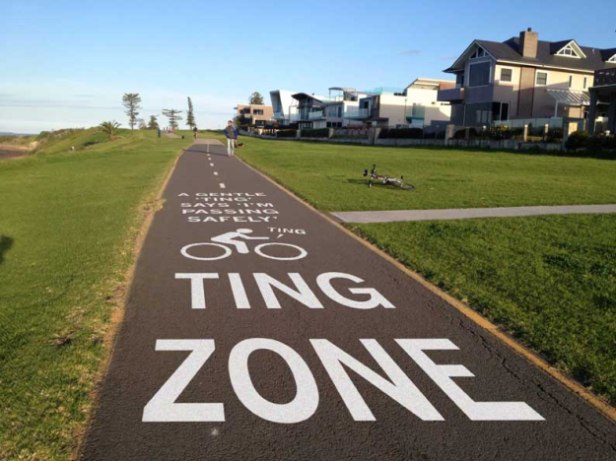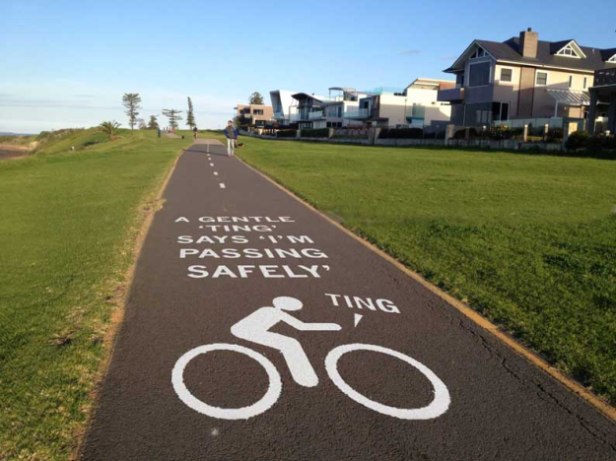 With so many men turning to bikes for exercise, and many having not a clue about good behaviour on shared paths, it’s getting scary to be a pedestrian, especially with children around.
With so many men turning to bikes for exercise, and many having not a clue about good behaviour on shared paths, it’s getting scary to be a pedestrian, especially with children around.
So, I’ve been thinking about how to communicate good shared path protocols for cyclists.
Building on thinking for a cycling behaviour strategy for the City of Sydney, I’ve just made some mock-ups (below).
First, it should be unmissable, big and bold, so no one can be in doubt that it’s important. So a full width path stencil should do the trick.
Second, it should clearly illustrate the behaviour, so cyclists know precisely what’s expected of them.
Thirdly, it should not tell people they are wrong (which will lead to resistance). It should just neutrally describe the desired behaviour. The aim should be to form in cyclists’ minds an idea of the behaviours other people expect as normal. That makes it about social norms rather than compliance.
Which behaviour? Other campaigns have focused on having a one-metre overtaking distance. However that’s liable to send the wrong message – that’s it OK to overtake at high speed (and still scare the bejesus out of people) so long as you’re a little distance away.
Better to focus on belling. The reason is that it focuses on communication, reminding training cyclists that pedestrians and other cyclists really exist, and expect to be communicated with. I think that, once you’re communicating, it helps you consider the other person’s point of view.
So “A gentle ting”. Three words that describe the desired behaviour with precision.
Here are the mock-ups.


Cities, Marketing and communications, Strategy
Communicating good cycling behaviour

Can I suggest that, if you’re serious about shared path safety, that you also create blog posts on how to encourage pedestrians to share these paths properly? Just as with cyclists, for many pedestrians sharing means “you can have the path when I’m done using it”. In other words, there are people in both groups who need educating.
I’ve been working on a shared path behaviour (belling for bike riders and not dashing in their path for pedestrians) and designed a very similar stencil so very excited that you think it’s the way to go. In the pre-project brainstorm session I hosted, quite a few bike riders mentioned that they feel like pedestrians don’t like belling or have been yelled at for belling (“yelled at for belling, yelled at for not belling” as a very courteous bike rider put it) so we used the language FRIENDLY BELLING SAYS ‘I’M PASSING SAFELY’ to introduce the idea that the bell is not an aggressive gesture. We sprayed it on Sunday afternoon and a few people stopped to check us out and have a chat. All of them were supportive of what we were doing but all of them had stories about pedestrians giving negative feedback to bike riders who DO communicate. It made me wonder, is it the right behaviour to target? Do we need to do a whole campaign for pedestrians to receive the behaviour that we have identified for their benefit in the first place? Is anything with behaviour change ever simple?
Hi Michaela,
It’s fantastic that you’re experimenting with belling stencils. Can you send me a photo or two, to les@enablingchange.com.au.
It’s interesting that so many cyclists are anxious about using their bells. Our research was with just two focus groups..the pedestrians were clear they welcomed belling – it was always better than being overtaken without warning. It would be interesting to do a little more research to confirm that..although it accords with common sense and my own experience of being a pedestrian. Obviously, being belled loudly, then immediately overtaken at speed is going to be just as shocking as not being belled at all.
How to interpret this?
First, keep in mind that all beliefs are, essentially, rationalisations for behaviours! So, not having a bell fitted needs a rationalisation, and ‘negative pedestrian response’ is perfect.
Second, belling is not the social norm, so the thought of doing it is going to make cyclists anxious.
Third, when I cycle on the local shared path am a constant beller…which I do as a ‘ting’ about 10 metres away, then pass carefully with at least 1 metre to spare. I’ve never had a negative reaction. So there is cleary a difference between rude and considerate belling – which is why I used the term ‘ting’ and showed an illustration with just one ‘ting’.
Fourth, cyclists are going to complain to you because the effect of the stencil is to tell them you think are are doing the wrong thing right now. So there will always be a degree of resistance. That means the language must be very carefully chosen.
Fifth, all this points to the fact that simply spaying a sign is not a complete behaviour change project.
For the City of Sydney, we devised a number of installations/events along the path that produced a conversation (real and virtual) between shared path users. There is learning for both sides to do…and enabling a conversation is the way to do it.
A stencil alone does not make a campaign…it’s one important element, and it’s the legacy in the environment that acts as a reminder of what the new social norm is.
And, in answer to your question, whether a different behaviour should be chosen. My conclusion is that belling is ideal because it is such a strong, highly observable, social action. And its high visibility (audibility) means that it can be contagious and normalise relatively quickly. It’s quite normal in other cycling cities around the world, so there is no inherent reason it can’t be adopted here…but doing think it will be a simple process! Regards – Les
Thanks Les. I should have said that the stencil is a precursor to the project (which is highly derivative of your work with City of Sydney because they are wonderfully generous with advice and even designs). I don’t get the impression that the feedback I’m getting is from resistant bike riders, rather that there different groups and the ones who are most likely to talk to me are the ones who are most sensitive to doing the right thing (the opposite of the stereotyped, aggressive fly past riders). Similarly, most pedestrians are probably appreciative and the ones they hear from are the grumpy minority. Compounded by the fact that most belling currently is telling pedestrians to move (of 61 interactions only 4 riders rang a bell/called out to indicate passing). We are printing up some suggested wording for short vocal calls as alternatives to the bell for bike riders who worry that people don’t like being belled so I’ll post again once we’ve been out and about with an update of how it went.